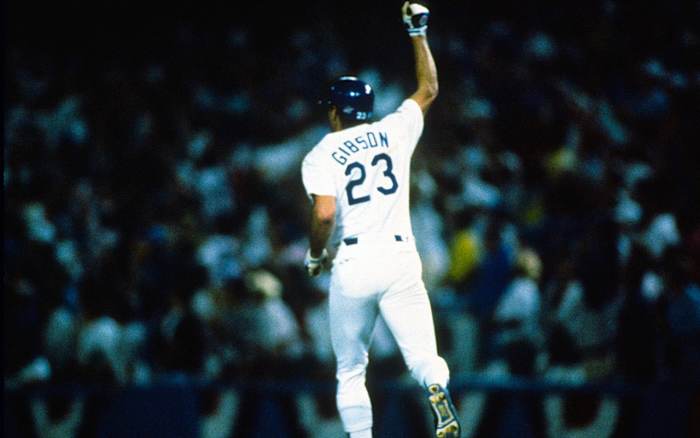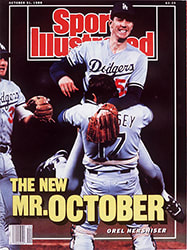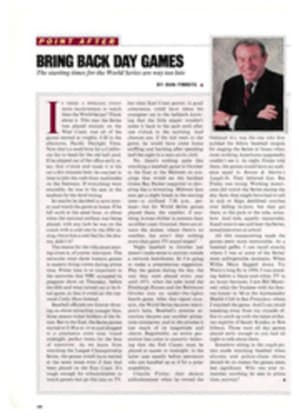Destiny's Boys
How in the world did it happen? How did a team with a lineup resembling that of the Albuquerque Dukes trounce a team reminiscent of the 1927 Yankees? How did the Los Angeles Dodgers beat the Oakland Athletics like a drum, four games to one, in the 1988 World Series? How come manager Tommy Lasorda and the rest of his Dodger Glue team get to go to the White House this week to shake hands and schmooze with the Prez, while Tony La Russa and his Abashed Brothers have gone home, shaking their heads?
Lasorda kept telling his players about David and Goliath—"The first time the underdog won," he said—and, given the relative strength of the combatants, this was an upset of Biblical proportions. The Dodgers jumped on NBC sportscaster Bob Costas for calling their Game 4 lineup perhaps the weakest in World Series history, but. truth be told, he was right. One would have to go back to the 1906 Chicago White Sox, known as the Hitless Wonders, to find a worse Series team, but it's interesting that the Sox beat the crosstown Cubs that year.
Not even the Dodger faithful had much faith. On the afternoon of Game 1 comedian Don Rickles was talking with Lasorda when the Dodger skipper excused himself to go give his players a pep talk. "You're not going out there and feed them some line of bull about how they're gonna win this thing without [Kirk] Gibson, are you?" asked Rickles.
"Yup," said Lasorda.
Even with Gibson, the 1988 edition was not quite up there in the Dodger Blue Pantheon with the '55, '59, '63, '65 or '81 world champions. Let's put it this way—among the following groups, which names don't belong: Hodges, Parker, Garvey, Stubbs? How about Robinson, Gilliam, Cey, Hamilton? Or Snider, Willie Davis, Guerrero, Shelby? Reese, Wills, Russell, Griffin?
The Dodgers themselves helped build up the Athletics' stature. "My God, they tote those 36-ounce bats and big biceps to the plate," said pitcher Tim Belcher. "Cy Young would be scared." Said centerfielder John Shelby, "We're just a bunch of has-beens, no-names and little-names trying to make names for ourselves." And in the end, they did.
The A's won Game 3, the first of three in Oakland, 2-1 on a ninth-inning homer by Mark McGwire off Jay Howell, but that was the A's only ascendant moment. With Orel Hershiser scheduled to start Game 5 for L.A., Oakland had to win Game 4, and it didn't, making two crucial errors and losing 4-3. Before Game 5 the Oakland Coliseum speakers blared out Bobby McFerrin's Don't Worry, Be Happy, as they had before the previous two games, but the whistling on McFerrin's pop hit was so much whistling in the dark. The A's had every reason to worry and nothing to be happy about. Hershiser pitched a four-hitter, and Mickey Hatcher and Mike Davis hit two-run homers as the Dodgers won 5-2 for their first world championship in seven years. The Dodgers rubbed it in a little by doing mock A's-style forearm bashes in the dugout following the home runs.
As the champagne flowed, owner Peter O'Malley compared these Dodgers with the 1959 team that beat the White Sox in six games. But the result of that Series was nowhere as big a surprise as this year's was. One man in a Los Angeles uniform did know the proper historical precedent for the victory: Third base coach Joe Amalfitano was a 20-year-old reserve infielder for the New York Giants when they beat the Cleveland Indians four straight in the 1954 World Series. "Same thing as '54," said Amalfitano. "We didn't have a chance against Cleveland." The Indians were considered a great team; they had won 111 games in the regular season. But in the first game of the Series, Willie Mays made his famous back-to-the-plate catch off Vic Wertz—a deed that had much the same disheartening effect on the Tribe as Gibson's Game 1 homer had on the A's—and the Giants went on to sweep the Indians. Little-used outfielder Dusty Rhodes, who hit two homers and drove in seven runs in the '54 Series, was the Hatcher (two homers, five RBIs) of his day.
So how did the 1988 Dodgers pull this off? There are all sorts of theories, both silly and serious. One suggestion, fresh out of one of Hollywood's recent body-switch movies, had the injured Gibson magically transferring his talents to L.A.'s other former college wide receiver, Hatcher. Even Gibson, who spent much of the Series angling for another at bat, admitted, "Mickey steps in and fills my role, and I filled his." Another theory had the Dodgers kidnapping Jose Canseco and replacing him with his identical twin brother, Ozzie, who hit .222 for the Huntsville (Ala.) Stars of the A A Southern League. Then there was this to ponder: Before Game 3, the only one the A's won, members of the Oakland grounds crew wore tuxedos, but after that they switched back to their regular attire. "You might be right," said one groundskeeper when asked before Game 5 if the tuxedos could have been a good-luck charm. "But did you ever try to bend over and clean second base in a cummerbund?"
There are other explanations, of course. In I Samuel 17:40 it's written that David "chose him five smooth stones out of the brook" before he went up against Goliath with a sling. With that in mind, here are five smooth stones the Dodgers used to knock off the A's:
HERSHISER. Two of the victories were his, and his alone: the three-hit shutout in Game 2 and the four-hit clincher in Game 5. His mastery of the A's and his surprising skill as a batsman are what made Hershiser the Series MVP (see box on page 36), but he helped the Dodgers in little ways as well. After Howell gave up the ninth-inning homer to McGwire in Game 3, Hershiser went onto the field and met Howell near the first base line. Hershiser wasn't merely consoling Howell. "I went out and asked him if he'd made a good pitch," said Hershiser. "At times like those, it doesn't do you any good to hang your head and get upset. If you get beat, you should learn something from it. If it was your best pitch, well, you gave it your best shot. If it wasn't, you shouldn't throw it again." The next night, Howell twice faced down the heart of the A's order to preserve the Dodgers' 4-3 victory.
Walking through Oakland's only clubhouse celebration of the Series was the A's Mr. October himself, Reggie Jackson. He congratulated the much-relieved A's, but he sounded an ominous note when he said that his former team had to win the next night's game. "Orel Hershiser goes in Game 5, and Orel Hershiser is the real thing," said Jackson. "He's 24 carat. He's 99 and 44/100 percent pure. He's Ivory Snow. He's Post Toasties. He's a rainy day for the other team. Hell, he's a smog alert."
Hershiser is known as Bulldog, and during the Series, his father, Orel Leonard Hershiser III, distributed stuffed bulldogs and bulldog pins to the other Dodgers. The trinkets had been sent by Mack Truck, which uses the bulldog as its symbol, and it came to be the Dodgers' symbol as well. Years and years ago. after John McGraw said that Connie Mack's expensive Philadelphia Athletics were mere "white elephants," the white elephant became the symbol of the A's. The cartoon image that emerges from this Series is of a herd of stampeding white elephants with bulldogs nipping at their feet.
GIBSON. His epic homer won Game 1, but Gibson really set things in motion in March when pitcher Jesse Orosco smeared eye black inside Gibson's hat. When Gibson discovered the practical joke, he stormed off the field. "No wonder this team finished fourth last season," said Gibson, and the other Dodgers got the message. "He made it cool to care about winning," says Hershiser. "He made it cool to be aggressive and to hustle and work hard."
So even though Gibson made his first and last appearance with two outs in the bottom of the ninth in Game 1, his presence was always felt.
LASORDA. He's full of prosciutto, but Lasorda did a superb job of both micro-and macromanaging. In the 4-3 victory in Game 4 he tried four hit-and-runs. The first one precipitated a two-run rally in the first, and the last, in the seventh, kept L.A. out of a double play and allowed its fourth run to score. In the fourth inning of the clinching victory Lasorda gave the green light on 3 and 0 to Davis, who had two homers and a .196 average in the regular season, and Davis responded with a two-run homer that gave Hershiser a 4-1 lead. Lasorda stayed one step ahead of La Russa during the entire Series, even though La Russa had a much more talented roster at his disposal.
As for the bigger picture, Lasorda kept his troops loose and confident, even though everyone else knew they had no business being in the Series. Some of his motivational techniques were childish—example: exploiting Costas's innocent remark about the Los Angeles lineup to the point that the Dodgers were chanting "Kill Costas!" in the clubhouse—but they worked, not so much on L.A. as on Oakland. La Russa was so obsessed with the emotional edge the Dodgers had that he showed uncharacteristic emotion himself, hollering at his team in the dugout, for example, during Game 3. Speaking of hollering, Lasorda wandered through the Los Angeles clubhouse after Game 4, yelling something about "the fruits of victory." One Dodger yelled back, "Why does it always have to be food with you. Tommy?"
With each injury to the patients of Jobe—team physician Dr. Frank Jobe—the Dodgers seemed to gain strength. First there was Gibson's right knee, severely sprained in Game 7 of the playoffs. Then there were the recurring ills of pitcher John Tudor's left elbow and outfielder Mike Marshall's back. Then catcher Mike Scioscia twisted his right knee sliding into second in Game 4. Lasorda never panicked, not even when the team he put on the field included Jose Gonzalez (.083 for the regular season), Franklin Stubbs (.223), Jeff Hamilton (.236), Alfredo Griffin (.199) and Davis. The last injury of the Series was suffered by Lasorda. At the presentation ceremonies he cut his forehead on one of the metal flags on the World Series trophy.
"He certainly did the finest job of managing I've seen," said Amalfitano. "You know, when you guys do those player-by-player matchups, you don't really think about the impact the managers have on a team. That was a big difference in this Series."
THE SCOUTS. At one point during the clubhouse celebration Scioscia went up to a nattily attired gentleman and said, "We couldn't have done it without you guys. Your reports were great." And the gentleman, Steve Boros, told Scioscia, "I could count the mistakes we made in the entire Series on one hand."
The reports were prepared by Boros, Mel Didier and Jerry Stephenson, and they had the A's pegged perfectly. Didier, for instance, wrote that "sure as shootin', Eckersley will throw a backdoor slider to a lefthanded hitter with a 3-and-2 count." That's precisely what Dennis Eckersley threw Gibson on that fateful 3-and-2 pitch in Game 1.
As for the Athletics' hitters, the reports basically said that all of them, with the exception of catcher Terry Steinbach, were susceptible to fastballs that climbed the ladder. The A's were so overwhelmed that after Hershiser went 3 for 3 at the plate in Game 2, it took until the third inning of Game 5 for the trio of Canseco, McGwire and Carney Lansford to surpass him in hits.
The Dodgers' scouting reports also gave them a certain psychological advantage. Imagine you're Stan Javier about to face Hershiser. He steps off the mound, pulls a laminated crib sheet from his back pocket, studies it for a moment, then looks in for the sign. If you're Javier, you might wonder. What does he know about me that I don't know?
The A's produced voluminous scouting reports too, but they couldn't have recommended the waist-high fastballs that Oakland pitchers kept throwing to Hatcher. As for a report on Hershiser, well, the Athletics began following him during his streak of scoreless innings, which was a tough time to find a way to score runs off a guy.
FRED CLAIRE. Rome, which is where the original Colosseum is and where O'Malley is sending his front office next month for a vacation, wasn't built in a day, and neither were the Dodgers. But Claire worked awfully fast after taking over as general manager when Al Campanis was ousted in April 1987. First, Claire signed Hatcher, who had been released by the Twins. Then he traded reliever Tom Niedenfuer for Shelby. He traded pitcher Rick Honeycutt to the A's in August '87 for a player to be named later, and the player turned out to be Belcher, whom the A's didn't think was ready for the majors. In a three-way deal with the Athletics and Mets in December, Claire acquired Howell, Griffin and Orosco. In the off-season he signed free agents Gibson, Davis and Rick Dempsey.
The Dodgers' Game 4 victory was a testament to Claire. Belcher got the win, Howell got the save, Hatcher had a key single in the first, Shelby drove in a run later in that inning, and Griffin scored what proved to be the winning run.
Claire won't stand pat this off-season—he can't afford to. Even with Gibson healthy, Claire is still short a big bat. He traded Pedro Guerrero to get Tudor, and now Tudor has a career-threatening injury. That means the Dodgers will have to sign Fernando Valenzuela, himself coming off a shoulder injury. And L.A. isn't very strong defensively, though the A's didn't put the ball in play enough to test the Dodgers' fielding.
"We'll see you guys here again," Davis told La Russa in the manager's office after the fifth game. Chances are the Dodgers won't be back soon. But then, the chances were they wouldn't win their division, beat the Mets in the playoffs or destroy the Athletics.
"I feel great about this club," said La Russa. "We played so well for so long. So while I feel bad that we lost, I feel great about the future." Just as La Russa said that, a familiar but unassuming figure walked into the office. "Young man, you were outstanding," La Russa told him. "It was almost a pleasure to watch you."
"I admire your ball club," said Hershiser. And La Russa took his cap off and tipped it to the pitcher.
Over in the Dodger clubhouse, A's coach Rene Lachemann said to Griffin, "I'm happy for you. I'm not happy for me, but I'm happy for you."
Griffin shrugged his shoulders as if to apologize and said, "Crazy game."
"Not so crazy, my friend," said Lachemann.
PHOTO
RONALD
C.
MODRA
The spirited Hatcher exulted after his bat helped Los Angeles win the Game 5 clincher.
PHOTO
JON SOOHOO/LOS ANGELES
DODGERS
Upon returning to Los Angeles, Lasorda gave thanks to the Big Dodger in the Sky.
PHOTO
HEINZ
KLUETMEIER
Gibson (far left) and Davis (center, in glasses) hit key homers in the Series; Hershiser pitched in with his pair of stellar starts.
PHOTO
RONALD C. MODRA
[See caption above.]
PHOTO
RICHARD
MACKSON
[See caption above.]
PHOTO
RICHARD
MACKSON
Scioscia severely twisted his knee in Game 4, further hobbling the injury-riddled Dodgers.
PHOTO
RONALD C.
MODRA
As the A's Canseco went—a meager .053 batting average in his first World Series—so went both his team and his helmet.
PHOTO
HEINZ KLUETMEIER
[See caption above.]
PHOTO
RONALD
C.
MODRA
Oakland fans supported their A's every witch way, but the Dodgers broke their spell.


